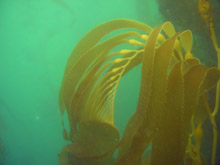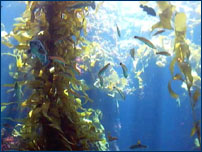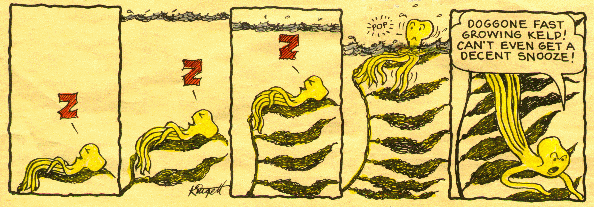Phaeophyceae
A Microbial Biorealm page on the phylum Phaeophyceae
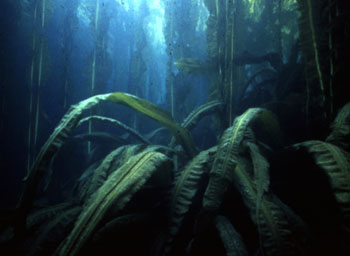
Classification
Higher order taxa
Eukayota; stramenopiles
Species
Pilayella littoralis, Macrocystis pyrifera, Laminaria digitata
Description and Significance
Phaeophyceae, or giant kelp, is a brown algae that is generally found in a costal, temperate, marine environment. It lives well in environments where the water is less than 72 degrees F and the water is less than 40m. There are about 265 genera, and 1500-2000 species of giant kelp and some can grow up to 200 ft tall, and grow about 2 ft. per day, other will only be 2 m tall. Commercially, kelp is a very useful product. It can produce Algin, which is an emulsifier, that is used in mover 300 different products. It is used for vitamins, acetone, iodine, paints, toothpaste, dental impression compound, ice cream, canned food, cosmetics, shampoo, and many processed foods. In World War II potash was extracted and was used to help make explosives.
Genome Structure
There have been two studies done on the genome of Phaeophyceae, one on the mitochondria of P. littoralis, which has 38007 base pairs, and the other on the mitochondria of L. digitata, which has 58507 base pairs (see links under genome). The species Myriotrichia clavaeformis is known to have 12 chromosomes, but some vary down to about 4 chromosomes depending on the species. The species Dictyota menstrualis has been shown to have an affect on the HIV type 1. The antiretroviral activity was attributed to two diterpenes,Da-1 and AcDa-1, from the alga. These, taken together, demonstrate that both diterpenes inhibit HIV-1 RT and consequently virus replication.
Cell Structure and Metabolism
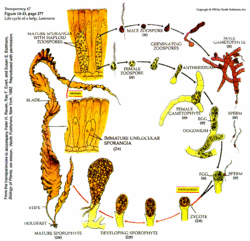
Phaeophyceae has a multicellular filamentous cells whose cell walls are composed of cellulose.The cellulose of the cell wall is stiffened by calcium alginate and a mucilaginous substance forms the amorphous part of the wall. A typical heterokont eyespot is present in most, but a few species lack this eyespot.
Phaeophyceae is photosynthetic, so it must live in water shallow enough so that the bottom light intensity is at least 1% of what the surface intensity is. The cholorplasts are generally discoid, with a choloplastic endoplasmic reticulum.The thylakoids are in groups of three, with girdle lamellae. The brown pigmentation in Phaeophyceae is mostly caused by the pigment fucoxanthin, but they also contain Chlorphylls a and c.
Reproduction can occur in three different ways with Phaeophyceae, it is either isogamous, anisogamous, or oogamous depending on the species. Most species are diplophaplontic, with an alternation of free-living generations. Macrocystis pyrifera begins as a single male or female gametophyte which produce either sperm or eggs and fertilize eachother. These fertilized sporophytes then release spores that will attach themselves to the ocean floor. An average kelp plant can release about a trillion spores a year, but very few reach adulthood due to lack of sunlight, being buried by sediment, being eaten, and nutrient limitation.
Ecology
Almost all species of Phaeophyceae are marine, though there are several small genera that live in fresh water. They are most abundant in temperate and polar waters, but there are several that live in the tropics. Most forms of kelp will bond themselves to a rock or hard surface on the bottom of the ocean. Kelp forests provide an ecosystem in itself. It is home to a diverse range of marine life that feed on it and on eachother. They offer hiding places for both prey and predators, and places for smaller creatures can grow. A kelp forest can be up to a mile wide by a few miles long and support thousands of species of animals. Sometimes the holdfast at the bottom of the plant will detach itself and the kelp will rise to the surface and float about, still growing until it reaches waters that are too hot or until it ends up on a beach. This floating mat can provide an oasis in the middle of the ocean for small and juvenile fish. But predators also will take advantage of this and stalk a patch of kelp for these small fish.
References
Blanchette, Carol. Kelp/Algal Ecology. Marine Science Institute, University of California.
Bushing, Dr. William W.. Giant Bladder Kelp (Macrocystis pyrifera)
Delwiche, Charles F. Heterokontophyta V — Phaeophyceae.University of Maryland.
Mathes, Dr. Martin C. Life Cycle of a Kelp, Laminaria (phaeophyta). College of William and Mary.
Ocean Light. Kelp Forest Photographs. Photos of Macrocystis pyrifera.
Point Lobos Sate Reserve. Cannery Point Wall. Giant Kelp Macrocystis pyifera.
The Marine Life Information Network for Britain and Ireland. Oarweed Laminaria digitata.
